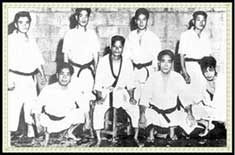|
History of Karate
Unfortunately there was little written about the early development of martial arts. Most of the history we have learned has been orally transmitted down through the centuries from teacher to student. A need for the refinement of fighting techniques came about due to mans basic survival instinct and the defense of family and possessions.
Okinawa, the largest of the Ryukyu Islands is strategically located between China and Japan. Both countries have occupied the islands at different times throughout history. Okinawan/Japanese karate had influences from many parts of the world, especially China. At the end of the 5th century A.D. a Buddhist priest by the name of Bodhidharma (Daruma in Japanese) traveled to China from India where he taught monks meditation and basic Indian fighting exercises. These moves evolved into what was later to become known as kung fu, Chu'an-fa, kempo and Chinese Boxing. Chinese boxing eventually made it’s way to Okinawa.
Okinawa had its own form of martial art; an aggressive closed fisted style known as te (hand). The king of Okinawa outlawed the possession of weapons in the mid fourteen hundreds. In 1609 the Satsuma clan of Japan invaded and, to control the population, reinstated the ban on owning weapons and training in the martial arts. Anyone caught disobeying would be severely punished. This resulted in te being practiced in secrecy. These bans accelerated the development of te as a way to fight oppression.
In the mid 1800’s Satsunuku Sakagawa, the number one student of te master Peichin Takahara, learned Chinese boxing under the famous military attaché known as Kusanku. The blend of the circular, defensive open hand style of the Chinese with the more offensive, closed handed style of the Okinawa’s was to become known as tode (karate). Sakagawa became known as Karate (tode) Sakagawa.
Three fighting styles were named after the villages where they developed. From Naha came Naha-te or Shorei-ryu, from Shuri came Shuri-te or Shorin-ryu and from Tomari came Tomari-te (later absorbed into Shorin-ryu). Some considered the original Naha styles preferable for larger stronger people and the styles from Shuri best for those smaller and quicker. Most karate systems can trace their origin to one or all of these villages.
Karate came out of hiding and into the public school system in 1903 as part of the curriculum. Then in 1915 an Okinawan schoolteacher named Gichin Funakoshi demonstrated karate in Japan. Funakoshi returned to Japan in 1922 to stay and teach the art. After World War II military personnel from around the world were introduced to the different styles of karate while stationed in Japan and Okinawa. Now karate has spread throughout the world where countless people are enjoying the benefits it offers.
Karate
 The origin of karate is obscured by myths and legends, but some facts are known. One legend states that at the time karate was developing there were many scoundrels that would rob or kill travelers whether they were monks or beggars. The monks were not recognized as clergyman by the people at this time and they were as likely to be killed by the robbers as anyone. Since monks were not allowed to carry weapons they were taught various forms of self-defense at the monasteries along with their Buddhist religion. The origin of karate is obscured by myths and legends, but some facts are known. One legend states that at the time karate was developing there were many scoundrels that would rob or kill travelers whether they were monks or beggars. The monks were not recognized as clergyman by the people at this time and they were as likely to be killed by the robbers as anyone. Since monks were not allowed to carry weapons they were taught various forms of self-defense at the monasteries along with their Buddhist religion.
Another legend says the art of karate was taught in secret for hundreds of years in Okinawa. Japan gained control over the island over 400 years ago. They confiscated everything resembling a weapon and blacksmiths were forbidden to manufacture any edged weapons. Karate, however, remained secret and underground. Through the centuries, Japanese invaders were found dead. Stories and rumors spread, and the only facts known about karate in the outside world were statistics of the number of invaders falling victim to its practitioners.
Karate remained secret on Okinawa until 1901 when Master Itosu opened the first karate school on the island. Ginchin Funakoshi was trained in this school and in 1916 he took karate to Japan in a series of demonstrations. They were so successful that he remained in Japan and established a style known as Shotokan. The Japanese systemized and established sport karate which has spread rapidly over the western world since the end of World War II.
|
